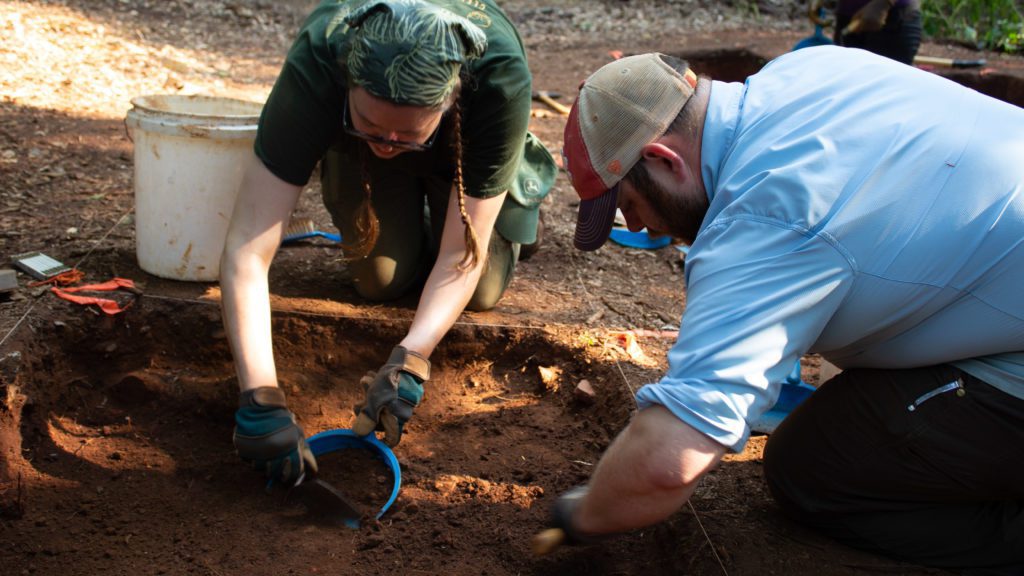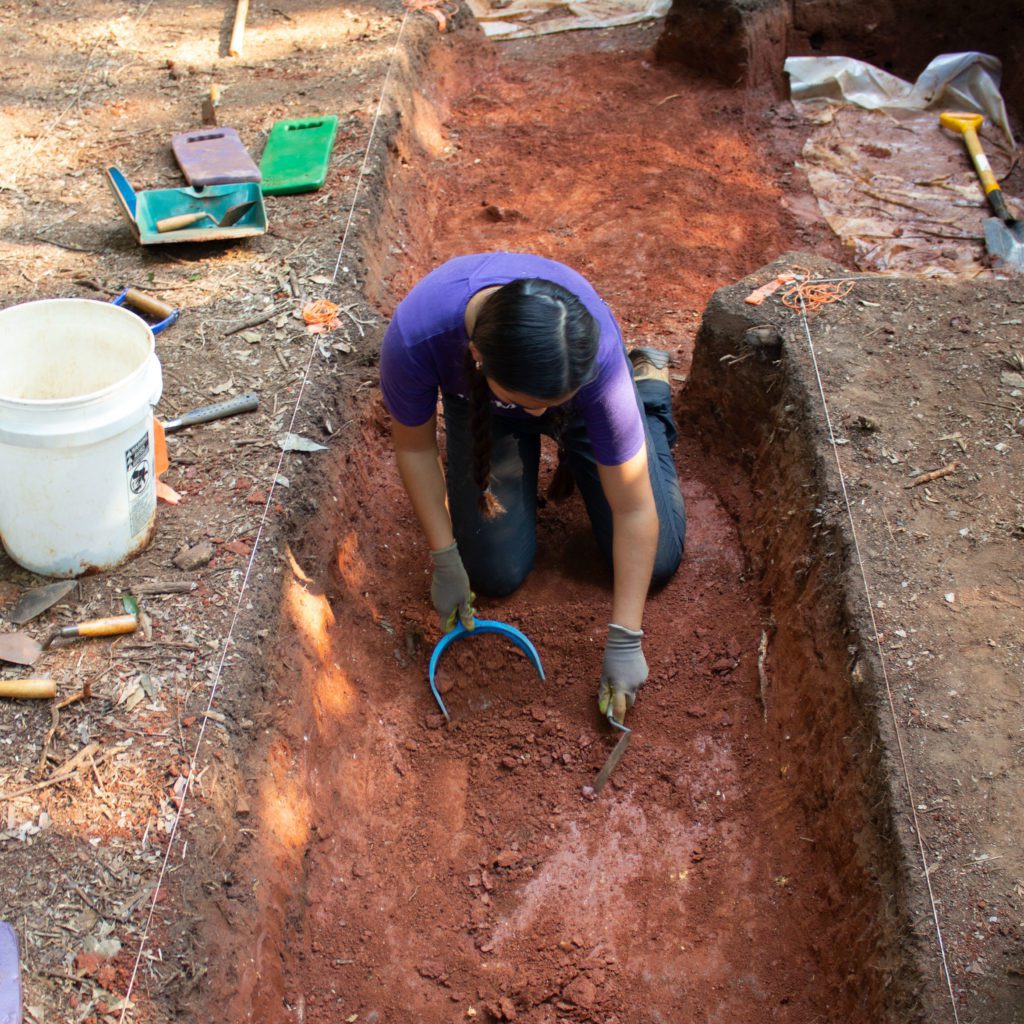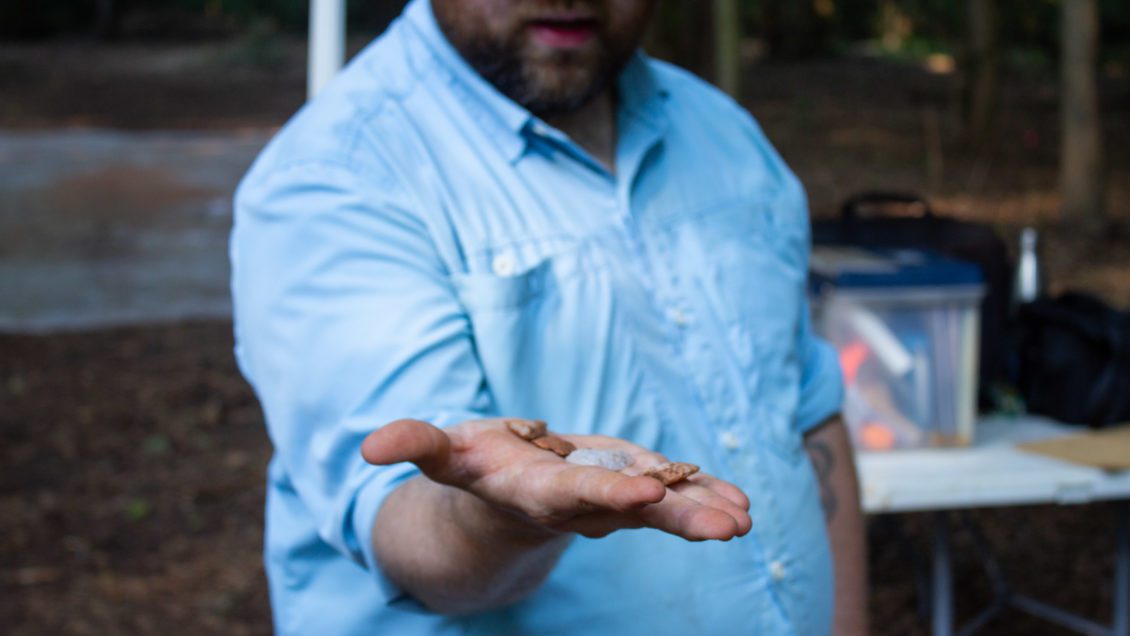Clemson University researchers have been awarded funds from the National Park Service to continue an archaeological and historical examination of Fort Rutledge on the Clemson University campus. The South Carolina militia constructed the fort in the fall of 1776 following an engagement with Loyalist forces and their Cherokee allies.
Clemson faculty members David Markus and Joshua Catalano have worked together to uncover the site’s history since fall 2018, and they finally broke ground on the dig in summer 2020. Markus, assistant professor in the Department of Sociology, Anthropology and Criminal Justice, said there is a good reason for the delay in any digging tools hitting ground.
“No one actually knows for sure where the fort is located,” Markus said. “According to records, the fort only stood for around four years before being torn down, so we can’t rely on the existing monument to indicate the fort’s original location, although it was a good place to start.”
The monument Markus speaks of is a roughly eight-foot-high, five-sided stone marker built in 1908 by Trustees of the Clemson Agriculture College at the request of the Daughters of the American Revolution. The location was chosen after a crew of African American convict laborers contracted out to the college conducted an excavation in 1907 of what was described as the ruins of a corner of the fort that was still visible at the time.
Catalano, assistant professor in the Department of History and Geography, said the initial dig suggests the fort was, in fact, built near the existing monument, which is located approximately 50 yards from the Clemson Pumping Station. This supports what the archival record and historic maps suggest.
The researchers now believe that this was the staging ground for the South Carolina militia’s ultimately successful efforts to starve out and demoralize the Cherokee people after the Battle of Esseneca. This small engagement, which occurred on August 1, 1776, takes its name from the Cherokee town now submerged under the waters of Lake Hartwell.

Markus and Catalano, along with several undergraduate students, uncovered various iron tool heads, musket balls and projectile points including arrowheads, but more importantly they found what they believe to be the remains of a wall that had been pushed over and buried for centuries. In addition, they discovered soil stains that point to the next areas that might yield more evidence of the fort. During archaeological digs, staining in soil can reveal where structures or objects have occupied areas underground.
Catalano said collaboration with Markus has provided an exciting, hands-on example of the scientific method at work. Initial geophysics and ground penetrating radar provided by Preservation South suggested where the dig should start, but both researchers continually modified their approach and their priorities as the dig revealed new objects, evidence and possibilities.
“The archival research that we are doing directly informs the archaeological plan,” Catalano said. “Rather than dividing work between the two of us, we have both been involved in the archival and archaeological aspects, so it’s been a really effective blending of our disciplines and our individual approaches.”
Catalano said the project has benefitted from collaboration with Clemson Historic Properties, managers of the Experimental Forest, and volunteers, who have coordinated with researchers to provide logistical support and labor. Further study of historical records and increased use of non-invasive geophysics thanks to the National Park Service funding will allow for more efficient, larger scale exploration to more effectively identify objects underground before digging begins.

The researchers said the students working on the dig were invaluable to the research and site activity. Markus said the students get hands-on, practical experience conducting archaeological fieldwork as well as long-term, continuous contact with instructors that simply cannot be duplicated in a classroom. Both researchers said that the enthusiasm and fresh perspectives from students also allowed them to see the site in different ways.
Although the protected nature of the landscape gives the researchers the benefit of time, Markus and Catalano have established an unofficial deadline for themselves to complete the dig and provide more concrete details on the fort in time for the United States Semiquincentennial in 2026. Thanks to initial funding from a Clemson University College of Architecture, Arts and Humanities Collaborative Grant, collaboration with other campus entities and more recent funding from the National Park Service, they are optimistic about the future of the research and meeting this goal.
Additionally, Markus and Catalano plan to develop an interpretive plan that advances a more complete account of the site’s history by convening a group of stakeholders among the Eastern Band of Cherokee Indians, the Nikwasi Initiative, and the Museum of the Cherokee in South Carolina. The researchers see this as a necessary, vital component of the work that will help to more accurately tell the story of the Cherokee people and Clemson.
“From an archaeological standpoint, Clemson is largely a 17,500-acre untapped resource,” Markus said. “From the plantations like Fort Hill to Cherokee sites dating back to before the American Revolution, we have so much Upstate history right here within our property boundaries. This is the perfect opportunity to more fully incorporate the Revolution story and the Cherokee story into our campus’s historical narrative.”
The Department of Sociology, Anthropology and Criminal Justice is part of the University’s College of Behavioral, Social and Health Sciences (CBSHS). Established in July 2016, CBSHS is a 21st-century, land-grant college that combines work in seven disciplines – Communication; Nursing; Parks, Recreation and Tourism Management; Political Science; Psychology; Public Health Sciences; Sociology, Anthropology and Criminal Justice – to further its mission of “building people and communities” in South Carolina and beyond.
Get in touch and we will connect you with the author or another expert.
Or email us at news@clemson.edu

